Large Meditation Emerald Buddha Statue Green Summer Armor 49cm Thai Amulet #0200
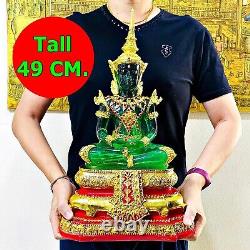
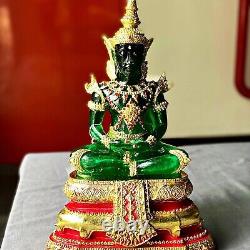
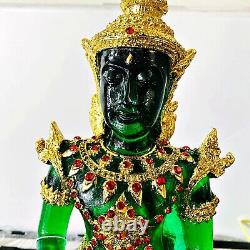
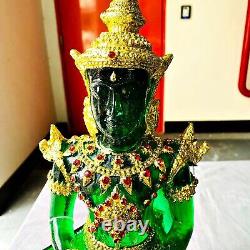
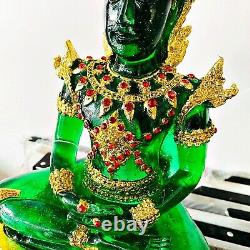
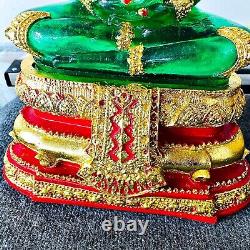
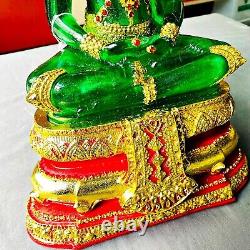
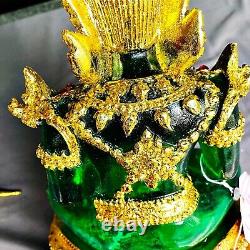
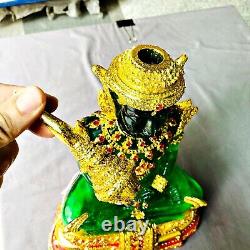
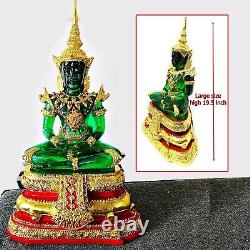

LARGE SEATED EMERALD BUDDHA STATUE MEDITATION AMULET GREEN GOLD ARMOR 49 CM. Summer Armor Edition, This Statue Depicts A Seated Meditating Buddha. That Is Symbolizes Of Peaceful. Believed Buddha Statue Will Bring Good Luck To Your Home So It Good For Decorative, Display In & Out Door. Mass Chant /Group 108 Monks Co-Blessing. Resin / Plastic / Fiber glass.
Good Effective for : Bz: Bring more power to govern people or organization. Item Received direct from temple. History: The original Emerald Buddha is made of jade and located within the Grand Royal Palace in the Wat Phra Kaew shrine in Thailand.
This is a Reproduction of most famoust Sculpture StatueThe Emerald Buddha. Large piece with Heavy Weight. Fine art made with Materials: Clear hard green lucite/plastic or translucent acrylic, highlighted by gold leaf and ruby red rhinestones, with an opaque resin base embellished with more gold leaf details and red enamel.
Extraordinary light catching figure with remarkable presence for your home alter or public shrine. Tiny gold leaf particles flake off easily and creates a kind of gold dust around itself. This Statue Depicts A Seated Meditating Buddha.
Brand New Condition with vintage style (made in old look). It's been in storage for MANY years. We just tore the old plastic wrapper off of this to photograph it. This statues are made by resin. The mold unique design replica from Grand Palace & Temple, The Emerald Buddha. Items created and finish each statue individually coated gold leaf and gems by hand made. This process includes sanding, polishing, painting and a final polish to give the statue that extra shine. This statue blessed by monk launch from MAHATAD temple, group monks mass chanted.SUMMER ARMOR EDITION, SEAT 5 INCH WIDE, THIS STATUE DEPICTS A SEATED MEDITATING BUDDHA. THAT IS SYMBOLIZES OF PEACEFUL. BELIEVED BUDDHA STATUE WILL BRING GOOD LUCK TO YOUR HOME SO IT GOOD FOR DECORATIVE, DISPLAY IN & OUT DOOR.
DateFounded during the Ayutthaya era. The Wat Mahatad is a large and busy temple in the old Rattanakosin district of Bangkok, just North of the Grand Palace. Its full name is Wat Mahatad Yuwaratrangsarit Rajaworamahavihara. The temple is very highly revered; it is one of the six temples of the highest grade of first class Royal temples. The temple enshrines relics of the Buddha.
The Wat Mahatad is one of the older temples of Bangkok; it was built during the time of the Ayutthaya Kingdom, before the city of Bangkok was founded in 1782. The temple was then known as the Wat Salak. During the centuries the temple was renovated and raised in class several times. It was later renamed to Wat Mahathat, a name often given to temples containing relics of the Buddha. The Wat Mahatad is an important temple for Buddhist studies, as it houses a well known meditation center and the first Buddhist University in the country, the Maha Chulalongkorn Raja Vidyalaya University where hundreds of monks study the teachings of the Buddha.
This temple ehas a large amulet market. This is a very fine amulet piece, it was incantation and bless with Good powerful magic. It is a mantras phonetic Praying word to consecrate and control power of this item.
If temple give khata with item. Is any object that is imbued with protective powers, and all cultures have manifestations of such objects. In the world of Thailand amulet, Many people believe the symbol of Load buddha has the power to ward off evil. That an object that is inscribed with the word of God, image of Lord buddha and religious narratives, symbol and signs, will protect the person who reads, touches, or sees it.
The surface of an amulet and talismans object can be covered with prayers, signs, numbers, and decorative motifs, and the object is carried in a pocket, or rolled and placed in an amulet case; some talismans are worn as clothin. The most efficacious amulet & talismans are those that are inscribed with prayers that remind people to lord Buddha and his narratives.
Is amulet Statue or figure of simbolic which use for put inside your home or office for make good luck and by catch FENG-SHUI. Feng shui - which literally translates to "wind and water" - is the ancient Chinese art of placement. The goal is to enhance the flow of chi (life force or spiritual energy), and to create harmonious environments that support health, beckon wealth and invite happiness. Feng Shui and Buddha Statues. Whenever you place any object in your home for a feng shui symbol or remedy, be sure you use the right element. For example, a metal Buddha placed in the northern sector of your home is typically an outstanding choice for location. The same statue placed in the east sector of your home won't have beneficial results. In fact, metal in a wood element sector can impede your feng shui design since metal cuts wood. Avoid putting a Buddha statue on the floor; this is deemed very disrespectful. If you opt for a Laughing Buddha, don't forget to rub his belly. While this isn't a requirement, many people claim that rubbing Buddha's belly everyday (the fatter the belly the better) will bring luck and prosperity to all in the home. Feng Shui Rules for Buddha Placement. The first thing you want to do when placing a Buddha statue or any statue of a deity is to make sure the location is truly one of reverence. This means you should never place one in a bathroom or kitchen. Also, you want the height of the Buddha to be at least eye level. Looking down at a deity is considered rude and irreverent. Avoid placing near electrical outlets, elect or equipment with moving parts and motors. This type of activity disturbs the surrounding energy.Most Auspicious Location for Your Buddha. Facing the main door: Many feng shui consultants recommend placing the Buddha opposite the main front door of a home on a table that is about thirty inches high. This location allows Buddha to interact with the chi energy entering your home.
From this position, the statue can neutralize any negative chi, and transform it from damaging to very lucky energy. Living room: Buddha is also quite comfortable in the living room. The best position for Buddha in the living room is facing the front door. On a desk: Students should place Buddha on their desks. This is a perfect location to enlist a little help with lessons and evoke Buddha auspicious energy for fulfilling your academic goals.Office table or reception's desk: For those that own a business, placing Buddha on a reception's desk can help bring prosperity to your company. Meditation garden: This is an ideal area for a Buddha statue. One of the most popular poses is the Meditation Buddha.
Buddha altar: If you're Buddhist, then you already have an altar, just make sure you place this altar in your home where meditation and reflection can be practiced. Yoga room: If you practice yoga, then you have a special room or area of a room in your home devote to your exercise.This is an excellent place for a Buddha statue. Just be sure to place it eye level or higher. History The Wat Phra Kaew chapel where the Emerald Buddha is now kept in Bangkok Historical sources indicate that the statue surfaced in northern Thailand in the Lannathai kingdom in 1434.
One account of its discovery tells that lightning struck a chedi in Wat Pa Yia (Bamboo Forest Monastery, later renamed Wat Phra Kaew) in the Chiang Rai, revealing a Buddha covered with stucco inside. The Buddha was then placed in the abbot's residence, who later noticed that stucco on the nose had flaked off, revealing a green interior. The abbot removed all the stucco and found a Buddha image made of a green semi-precious stone, which became known as Phra Kaew Morakot or the Emerald Buddha. "Emerald" here simply means "green coloured" in Thai. [5][6] Some art historians describe the Emerald Buddha as belonging to the Chiang Saen Style of the 15th century AD, which would mean it is of Lannathai origin.Wat Phra Kaeo in Chiang Rai, where the Emerald Buddha was found. King Sam Fang Kaen of Lannathai wanted it in his capital, Chiang Mai, but the elephant carrying it insisted, on three separate occasions, on going instead to Lampang. This was taken as a divine sign, and the Emerald Buddha stayed in Lampang in a specially-built temple for the next 32 years.
In 1468, it was moved to Chiang Mai by King Tiloka, where it was kept in a niche in a large stupa called Chedi Luang. [7] The Emerald Buddha remained in Chiang Mai until 1552, when it was taken to Luang Prabang, then the capital of the Lao kingdom of Lan Xang. Some years earlier, the crown prince of Lan Xang, Setthathirath, had been invited to occupy the vacant throne of Lannathai as his mother was the daughter of the king of Chiang Mai who had died without a son. [7] However, Prince Setthathirath also became king of Lan Xang when his father, Photisarath, died.Haw Phra Kaew in Vientiane In 1564, King Setthathirath moved it to Vientiane, which he had made his new capital due to Burmese attacks and where the Buddha image was housed in Haw Phra Kaew. [8] The Buddha image would stay in Vientiane for the next 214 years. [7] In 1779, the Thai General Chao Phraya Chakri put down an insurrection, captured Vientiane and took the Emerald Buddha to Siam. It was installed in a shrine close to Wat Arun in Thonburi, its new capital.
Chao Phra Chakri then took over the reins and founded the Chakri Dynasty of Rattanakosin Kingdom. He adopted the title Rama I and shifted his capital across the Menam Chao Phra river to its present location in Bangkok, and constructed the new Grand Palace including Wat Phra Kaew within its compound. Wat Phra Kaew was consecrated in 1784, and the Emerald Buddha was moved with great pomp and pageantry to its current home in the Ubosoth of the Wat Phra Kaew temple complex on 22 March 1784. Legends View of the Emerald Buddha on its pedestal The legend of the Emerald Buddha is related in number of sources, in particular Ratanabimbavamsa or The Chronicle of the Emerald Buddha written in Pali by Brahmarajapañña in the 15th century.
[9] The story is a mix of fact and fables with some variations to the story. [10] According to the legend, the Emerald Buddha was created in India in 43 BC by a saint in India named Nagasena in the city of Pataliputra (today's Patna). Nagasena was said to have made the Emerald Buddha image made with the help of Hindu god Vishnu and demigod Indra, 500 years after Buddha attained Nirvana.He was said to have predicted that:[2] The image of the Buddha is assuredly going to give to religion the most brilliant importance in five lands, that is in Lankadvipa (Sri Lanka), Ramalakka, Dvaravati, Chieng Mai and Lan Chang (Laos). The legends state that after remaining in Pataliputra for three hundred years, it was taken to Sri Lanka to save it from a civil war. A version of the legend stated that in 457, King Anuruth of Burma sent a mission to Ceylon to ask for Buddhist scriptures and the Emerald Buddha, in order to support Buddhism in his country.
When the Thais captured Angkor Wat in 1432 (following the ravage of the bubonic plague), the Emerald Buddha was taken to Ayutthaya, Kamphaeng Phet, Laos and finally Chiang Rai, where the ruler of the city hid it until it was found in 1434. The image The Buddha image is made of a semi-precious green stone, [1] described variously as jade or jasper rather than emerald, [3][11] as "emerald" here refers to its colour rather than the stone.
[12] The image has not been analyzed to determine its exact composition or origin. The figure is 19 inches (48 cm) wide at the lap, and 26 inches (66 cm) high. [4] The Buddha is in a seated position, with the right leg resting on the left one, a style that suggest it might have been carved in the late Chiangsaen or Chiangmai school, not much earlier than the fifteenth century A. However, the meditation pose of the statue was not popular in Thailand but looks very much like some of the Buddha images of Southern India and Sri Lanka, which led some to suggest an origin in India or Sri Lanka. Seasonal attire Closeup of Emerald Buddha in summer season attire The Emerald Buddha is adorned with three different sets of gold seasonal costume; two were made by Rama I, one for the summer and one for the rainy season, and a third made by Rama III for the winter or cool season.
[7] The clothes are changed by the King of Thailand, or the Crown Prince in his stead, [13] in a ceremony at the changing of the seasons - in the 1st Waning of lunar months 4, 8 and 12 (around March, August and November). [14] For the three seasons, the three set of costumes for the Emerald Buddha:[1][14] Hot season - a stepped, pointed headpiece; a breast pendant; a sash; a number of armlets, bracelets and other items of royal attire.
All items are made of enameled gold and embeded with precious and semi-precious stones. Rainy season - a pointed headpiece of enameled gold studded with sapphires; a gold-embossed monk's robe draped over one shoulder. Cool season - a gold headpiece studded with diamonds; a jewel-fringed gold-mesh shawl draped over the rainy season attire. The sets of gold clothing not in use at any given time are kept on display in the nearby Pavilion of Regalia, Royal Decorations and Thai Coins on the grounds of the Grand Palace, where the public may view them.
Worship and ceremonies Early in the Bangkok period, the Emerald Buddha used to be taken out of its temple and paraded in the streets to relieve the city and countryside of various calamities (such as plague and cholera). However, this practice was discontinued during Rama IV's reign as it was feared that the image could get damaged during the procession and also a practical line of thinking that Rama IV held "that diseases are caused by germs, not by evil spirits or the displeasure of the Buddha". [2] The image also marks the changing of the seasons in Thailand, with the king presiding over the seasonal ceremonies.
It is a significant ritual held at this temple three times a year, whereby the dress of the deity is changed at the start of each of the three seasons. The astrological dates for the ritual ceremonies, at the changing of the seasons, followed are in the 1st Waning Moon of Lunar Months 4, 8 and 12 (around March, July and November).Rama I initiated this ritual for the hot season and the rainy season, Rama III introduced the ritual for the winter season. [2][12] The robes, which the image adorns, represents that of monks and the King, depending on the season, a clear indication of highlighting its symbolic role "as Buddha and the King", which role is also enjoined on the Thai King who formally dresses the Emerald Buddha image. [3] The costume change ritual is performed by the Thai king who is the highest master of ceremonies for all Buddhist rites.
During the ceremony, the king first climbs up to the pedestal, cleans the image by wiping away any dust, and changes the gold headdress of the Emerald Buddha. The king then worships nearby while an attendant performs the elaborate ritual of changing garments. [14] The king also sprays lustral water upon his subjects waiting outside the ordination hall, a privilege previously afforded only to the princes and officials who were attending the ceremony inside the ubosoth. [7] Ceremonies are also performed at at the Emerald Buddha temple at other occasions such as the by Chakri Day (begun on April 6, 1782), a national holiday to honour founding of the Chakri dynasty. The King and Queen, entourage of the royal family as well as the Prime Minister, officials in the Ministry of Defence, and other government departments, offer prayers at the temple.
If want To Put a FRAME CASE fit for this item or. Do a water proof frame case for this item. See my other Whole sale items at here. Stock Photo of item(s). 100% guarantee about condition detail will similar as you see.(this process may take 2-3 day for take a photo). Due to many type of monitors, the actual color may be a little bit different as shown. Damaged or incorrect item received.
I will resend new one to replacement. FIND OUT MORE:LARGE SEATED EMERALD BUDDHA STATUE MEDITATION AMULET GREEN GOLD ARMOR 49 CM, Mass Chant /Group 108 Monks Co-Blessing, Resin / Plastic / Fiber glassBrand new (never use), Bz: Bring more power to govern people or organization, BUCHA STATUE (FENG-SHUI) Positive Energy!!
This item is in the category "Collectibles\Religion & Spirituality\Buddhism\Statues & Figures". The seller is "realamulet" and is located in this country: TH. This item can be shipped worldwide.- MATERIAL: RESIN
- Featured Refinements: Large Buddha Statue
- Dimension: HIGH 19 INCH
- Handmade: Yes
- Type: Amulets
- Modified Item: No
- Country/Region of Manufacture: Thailand
- Religion: Buddhism
- Monk maker: Mass Chant /Group 108 Monks Co-Blessing

